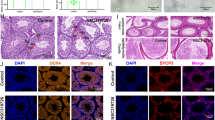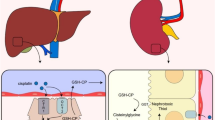Abstract
Cisplatin is a widely used anti-cancer drug. However, cisplatin is limited in clinical treatment because of its severe nephrotoxicity. This study reported whether O-GSP can antagonize the cisplatin-induced cytotoxicity in HEK293 cells through inducing HO-1 protein expression. We previously demonstrated O-GSP can increase the survival rate of HEK293 and have protective effect on HEK293 cells. Herein, We found that O-GSP can antagonize cisplatin nephrotoxicity through regulating the expression of HO-1. O-GSP promotes the translocation of Nrf2 in the nucleus, and activates the ERKN JNK pathway and p38 MAPK pathway. Interestingly, p38 MAPK plays a major role in HO-1 expression induced by O-GSP. And O-GSP can modulate the decrease of Nrf2 and HO-1 expression induced by cisplatin, and improve the cisplatin-induced activity and apoptosis rate of cells by stimulating the expression of HO-1. However, the protective effects of O-GSP are inhibited by ZnPP IX. Collectively, the results indicated that O-GSP induced the expression of HO-1 through p38MAPK and Nrf2 pathway in HEK293 cells.





Similar content being viewed by others
Data Availability
Every statistic in this study is true and valid.
References
Houde, V., Grenier, D., & Chandad, F. (2006). Protective effects of grape seed proanthocyanidins against oxidative stress induced by lipopolysaccharides of periodontopathogens. Journal of Periodontol, 77(8), 1371–1379. https://doi.org/10.1902/jop.2006.0504192.
Bao, L., Cai, X., & Zhang, Z., et al. (2014). Grape seed procyanidin B2 ameliorates mitochondrial dysfunction and inhibits apoptosis via the AMP-activated protein kinase–silent mating type information regulation 2 homologue 1–PPARγ co-activator-1α axis in rat mesangial cells under high-dose glucosamine. British Journal of Nutrition, 113(1), 1–10. https://doi.org/10.1017/S000711451400347X.
Dan L., Jianjun D., Snehal J., et al. (2018). Monomeric catechin and dimeric procyanidin B2 against human norovirus surrogates and their physicochemical interactions. Food Microbiology, S0740002018300637. https://doi.org/10.1016/j.fm.2018.06.009.
Talalay, P., Dinkova-Kostova, A. T., & Holtzclaw, W. D. (2003). Importance of phase 2 gene regulation in protection against electrophile and reactive oxygen toxicity and carcinogenesis.J. Advances in Enzyme Regul, 43, 121–134. https://doi.org/10.1016/S0065-2571(02)00038-9.
Rubiolo, J. A., Mithieux, G., & Vega, F. V. (2008). Resveratrol protects primary rat hepatocytes against oxidative stress damage: activation of the Nrf2 transcription factor and augmented activities of antioxidant enzymes. European Journal of Pharmacolgy, 591(1/2/3), 66–72. https://doi.org/10.1016/j.ejphar.2008.06.067.
Ryters, W., Xis, C., & Hartefieidc, L. (2002). Mitogen activeted protein kinase(mapk) pathway regulates heme oxygenase-1 gene expression by hypoxia in vascular cells. Antioxidants & Redox Signaling, 4(4), 587–592. https://doi.org/10.1089/15230860260220085.
Paine, A., Eiz-Vesper, B., & Blasczyk, R., et al. (2010). Signaling to heme oxygenase-1 and its anti-inflammatory therapeutic potential. Biochemical Pharmacology, 80(12), 1895–1903. https://doi.org/10.1016/j.bcp.2010.07.014.
Park, S. Y., Park, D. J., & Kim, Y. H., et al. (2011). Upregulation of heme oxygenase-1 via PI3K/Akt and Nrf-2 signaling pathways mediates the anti-inflammatory activity of Schisandrin in Porphyromonas gingivas LPS-stimulated macrophages. Immunology Letters, 139(1-2), 93–101. https://doi.org/10.1016/j.imlet.2011.05.007.
Tiwari, M., Gupta, A., & Sharma, A., et al. (2018). Role of mitogen activated protein kinase and maturation promoting factor during the achievement of meiotic Competency in mammalian oocytes. Journal of Cellular Biochemistry, 119(1), 123–129.
Yaffe, M. B., & Fink, M. P. (2000). Cellular signaling in critical care–putting the pieces together. Critical Care Medicine, 28(4 Suppl), 1–2. https://doi.org/10.1097/00003246-200004001-00001.
Fiorani, M. I., Guidarelli, A., & Blasa, M., et al. (2010). Mitochondria accumulate large amounts of quercetin: prevention of mitochondrial damage and release upon oxidation of the extramitochondrial fraction of the flavonoid. The Journal of Nutritional Biochemistry, 21(5), 397–404. https://doi.org/10.1016/j.jnutbio.2009.01.014.
Saad, A. A., Youssef, I. M., & El-Shennawy, K. L. (2009). Cisplatin induced damage in kidney genomic DNA and nephrotoxicity in male rats: the protective effect of grape seed proan -thocyanidin extract. Food and Chemical Toxicology, 47, 1499–1506. https://doi.org/10.1016/j.fct.2009.03.043.
Karasawa, T., & Steyger, P. S. (2015). An integrated view of cisplatin-induced nephrotoxicity and ototoxicity. Toxicology Letters, 237(3), 219–227. https://doi.org/10.1016/j.toxlet.2015.06.012.
Chirino, I. Y., & Pedraza-Chaverri., J. (2008). Role of oxidative and nitrosative stress in cisplatin -induced nephrotoxicity. Experimental and Toxicologic Pathology, 9(30), 1–20. https://doi.org/10.1016/j.etp.2008.09.003.
Lian, Y., Gao, L., & Guo, Y., et al. (2016). Protective effect of grape seed oligomeric proanthocyanidins extract against cisplatin-induced nephrotoxicity in HEK293 cell and effect on anticancer activity of cisplatin in human lung cancer cells. Food Science, 37(07), 182–186. https://doi.org/10.7506/spkx1002-6630-201607033.
Guo, Z., Gao, L., & Li, Z. (2014). Protective effect of grape seed proanthocyanidin extract against cisplatin-induced apoptosis in human embryonic kidney cells. Food Science, 35(01), 234–238. https://doi.org/10.7506/spkx1002-6630-201401046.
Guo, Z., Gao, L., & Li, Z. (2013). Protective effect of grape seed proanthocyanidin extract against cisplatin-induced nephrotoxicity in mice. Food Science, 34(21), 325 https://doi.org/10.7506/spkx1002-6630-201321065.
Choi, B. M., Kim, Y. M., & Jeong, Y. R., et al. (2004). Induction of heme oxygenase-1 is involved in anti-proliferative effects of paclitaxel on rat vascular smooth muscle cells. Biochemical and Biophysical Research Communications, 321(1), 132–137.
Kietzmann, T., Samoylenko, A., & Immenschuh, S. (2003). Transcriptional regulation of heme oxygenase-1 gene expression by MAP kinases of the JNK and p38 pathways in primary cultures of rat hepatocytes. The Journal of Biological Chemistry, 278(20), 17927–17936.
Li, C., Hossieny, P., & Wu, B. J., et al. (2007). Pharmacologic induction of heme oxygenase-1. Antioxidants & Redox Signaling, 9, 2227–2239. https://doi.org/10.1089/ars.2007.1783.
Motterlini, R., & Foresti, R. (2014). Heme oxygenase-1 as a target for drug discovery. Antioxidants & Redox Signaling, 20(11), 1810–1826. https://doi.org/10.1089/ars.2013.5658.
Moon, M. K., Choi, B. M., & Oh, G. S., et al. (2003). Catalposide protects Neuro 2A cells from hydrogen peroxide-induced cytotoxicity via the expression of heme oxygenase-1. Toxicology Letters, 145, 46–54. https://doi.org/10.1016/s0378-4274(03)00268-6.
Chen, C. Y., Jang, J. H., & Li, M. H., et al. (2005). Resveratrol upregulates heme oxygenase-1 expression via activation of NF-E2-related factor2 in PC12 cells. Biochemical and Biophysical Research Communications, 331, 993–1000. https://doi.org/10.1016/j.bbrc.2005.03.237.
Scapagnini, G., Foresti, R., & Calabrese, V., et al. (2002). Caffeic acid phenethyl ester and curcumin: a novel class of heme oxygenase-1 inducers. Molecular Pharmacology, 61, 554–561. https://doi.org/10.1124/mol.61.3.554.
Hu, Q., Zhang, D. D., & Wang, L., et al. (2012). Eriodictyol-7-O-glucoside, a novel Nrf2 activator, confers protection against cisplatin-induced toxicity. Food and Chemical Toxicology, 50(6), 1927–1932. https://doi.org/10.1016/j.fct.2012.03.059.
Sahin, K., Tuzcu, M., & Sahin, N., et al. (2010). Nrf2/HO-1 signaling pathway may be the prime target for chemoprevention of cisplatin-induced nephrotoxicity by lycopene. Food and Chemical Toxicology, 48(10), 2670–2674. https://doi.org/10.1016/j.fct.2010.06.038.
Sahin, K., Tuzcu, M., & Gencoglu, H., et al. (2010). Epigallocatechin-3-gallate activates Nrf2/HO-1 signaling pathway in cisplatin-induced nephrotoxicity in rats. Life Sciences, 87(7-8), 240–245. https://doi.org/10.1016/j.lfs.2010.06.014.
Choi, B. M., Kim, S. M., & Park, T. K., et al. (2007). Piperine protects cisplatin-induced apoptosis via hemeoxygenase-1 induction in auditory cells. The Journal of Nutritional Biochemistry, 18(9), 615–622. https://doi.org/10.1016/j.jnutbio.2006.11.012.
Tayem, Y., Green, C. J., & Motterlini, R., et al. (2014). Isothiocyanate-cysteine conjugates protect renal tissue against cisplatin-induced apoptosis via induction of heme oxygenase-1. Pharmacological Research, 81, 1–9. https://doi.org/10.1016/j.phrs.2014.01.001.
Katoh, Y., & Itoh, K. (2001). Two domains of Nrf2 cooperatively bind CBP, a CREB binding protein, and synergistically activate transription.Genes to Cells, 6, 857–868. https://doi.org/10.1046/j.1365-2443.2001.00469.x.
Ohta, T., & lijima, K. (2008). Loss of keap1 function activates Nrf2 and provides advantages for lung cancer cell growth. Cancer Research, 68, 1303–1309. https://doi.org/10.1158/0008-5472.CAN-07-5003.
Miao, L., Shu-Hua, Y., & Jian-Xin, H., et al. (2016). The protective effect of grape-seed proantho- cyanidin extract on oxidative damage induced by zearalenone in kunming mice liver. International Journal of Molecular Sciences, 17(6), 808 https://doi.org/10.3390/ijms17060808.
Biying L., Haili Z., Xiao T., et al. (2017). GSPE reduces lead-induced oxidative stress by activating the Nrf2 pathway and suppressing miR153 and GSK-3β in rat kidneyJ. Oncotarget, 8(26). https://doi.org/10.18632/oncotarget.15033.
Anil, K. J. (2004). Nrf2 signaling in coordinated activation of antioxidant gene expression. Free Radical Biology and Medicine, 36(10), 1199–1207. https://doi.org/10.1016/j.freeradbiomed.2004.02.074.
Yu, R., Chen, C., & Mo, Y. Y., et al. (2000). Activation of mitogen-activated protein kinase pathways induces antioxidant response element-mediated gene expression via a Nrf2-dependent mechanism. Journal of Biological Chemistry, 275(51), 39907–39913. https://doi.org/10.1074/jbc.M004037200.
Kietzmann, T., Samoylenko, A., & Immenschuh, S. (2003). Heme oxygenase-1 gene activation by the NAD(P)H oxidase inhibitor4-(2-amino-ethyl) benzenesulfonyl fluoride via a protein kinase B, p38-dependent signaling pathway in monocytes. Journal of Biological Chemistry, 280, 21820–21829. https://doi.org/10.1074/jbc.M502943200.
Elbirt, K. K., Whitmarsh, A. J., & Davis, R. J., et al. (1998). Mechanism of sodium arsenite-mediated induction of heme oxygenase-1 in hepatoma cells. Role of mitogen-activated protein kinases. Journal of Biological Chemistry, 273, 8922–8931. https://doi.org/10.1074/jbc.273.15.8922.
Xu, C., Yuan, X., & Pan, Z., et al. (2006). Mechanism of action of isothiocyanates: the induction of ARE-regulated genes is associated with activation of ERK and JNK and the phosphorylation and nuclear translocation of Nrf2. Molecular Cancer Therapeutics, 5(8), 1918–1926. https://doi.org/10.1158/1535-7163.MCT-05-0497.
Balogun, E., Hoque, M., & Gong, P., et al. (2003). Curcumin activates the haem oxygenase-1 gene via regulation of Nrf2 and the antioxidant-responsive element. Biochemical Journal, 371(3), 887–895. https://doi.org/10.1042/BJ20021619.
Juan, S. H., Cheng, T. H., & Lin, H. C., et al. (2005). Mechanism of concentration-dependent induction of heme oxygenase-1 by resveratrol in human aortic smooth muscle cells. Biochemical Pharmacology, 69(1), 41–48. https://doi.org/10.1016/j.bcp.2004.09.015.
Maines, M. D. (1997). The heme oxygenase system: a regulator of second messenger gases. Annual Review of Pharmacology and Toxicology, 37, 517–554. https://doi.org/10.1146/annurev.pharmtox.37.1.517.
Choi, B. M., Pae, H. O., & Kim, Y. M., et al. (2003). Nitric oxide-mediated cytoprotection of hepatocytes from glucose deprivation-induced cytotoxicity: involvement of heme oxygenase-1. Hepatology, 37(4), 810–823. https://doi.org/10.1053/jhep.2003.50114.
Nath, K. A. (2006). Heme oxygenase-1: a provenance for cytoprotective pathways in the kidney and other tissues. Kidney International, 70(3), 432–443. https://doi.org/10.1038/sj.ki.5001565.
Ferris, C. D., Jaffrey, S. R., & Sawa, A., et al. (1999). Heme oxygenase-1 prevents cell death by regulating cellular iron.Nature Cell Biology, 1(3), 152–157. https://doi.org/10.1038/11072.
Petrache, I. L., Otterbein, E., & Alam, J., et al. (2000). Heme oxygenase-1 inhibits TNF-α-induced apoptosis in cultured fibroblasts. American Journal of Physiology. Lung Cellular and Molecular Physiology, 278(2), L312–L319. https://doi.org/10.1046/j.1365-201X.2000.00663.x.
Motterlini, R., Foresti, R., & Bassi, R., et al. (2000). Curcumin, an antioxidant and anti-inflammatory agent, induces heme oxygenase-1 and protects endothelial cells against oxidative stress. Free Radical Biology and Medicine, 28(8), 1303–1312. https://doi.org/10.1016/S0891-5849(00)00294-X.
Brouard, S., Otterbein, L. E., & Anrather, J., et al. (2000). Carbon monoxide generated by suppresses endothelial cell apoptosis. Journal of Experimental Medicine, 192(7), 1015–1026. https://doi.org/10.1084/jem.192.7.1015.
Acknowledgements
This work project is founded by grants from Scientific Research Project of Beijing Union University: Opening Project of Key Laboratory (NO.LDSP201801).
Author information
Authors and Affiliations
Corresponding author
Ethics declarations
Conflict of Interest
The authors declare that they have no conflict of interest.
Additional information
Publisher’s note Springer Nature remains neutral with regard to jurisdictional claims in published maps and institutional affiliations.
Rights and permissions
About this article
Cite this article
Han, H., Wang, H., Du, Y. et al. Grape Seed Procyanidins Attenuates Cisplatin-induced Human Embryonic Renal Cell Cytotoxicity by Modulating Heme Oxygenase-1 in Vitro. Cell Biochem Biophys 77, 367–377 (2019). https://doi.org/10.1007/s12013-019-00890-5
Received:
Accepted:
Published:
Issue Date:
DOI: https://doi.org/10.1007/s12013-019-00890-5




